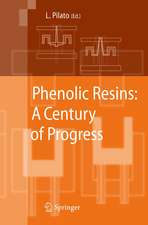Polyampholytes: Synthesis, Characterization and Application
Autor Sarkyt E. Kudaibergenoven Limba Engleză Hardback – 30 apr 2002
| Toate formatele și edițiile | Preț | Express |
|---|---|---|
| Paperback (1) | 639.90 lei 6-8 săpt. | |
| Springer Us – 5 noi 2012 | 639.90 lei 6-8 săpt. | |
| Hardback (1) | 648.56 lei 6-8 săpt. | |
| Springer Us – 30 apr 2002 | 648.56 lei 6-8 săpt. |
Preț: 648.56 lei
Preț vechi: 763.01 lei
-15% Nou
Puncte Express: 973
Preț estimativ în valută:
124.10€ • 129.92$ • 102.69£
124.10€ • 129.92$ • 102.69£
Carte tipărită la comandă
Livrare economică 05-19 aprilie
Preluare comenzi: 021 569.72.76
Specificații
ISBN-13: 9780306467813
ISBN-10: 030646781X
Pagini: 214
Ilustrații: X, 214 p.
Dimensiuni: 178 x 254 x 21 mm
Greutate: 0.64 kg
Ediția:2002
Editura: Springer Us
Colecția Springer
Locul publicării:New York, NY, United States
ISBN-10: 030646781X
Pagini: 214
Ilustrații: X, 214 p.
Dimensiuni: 178 x 254 x 21 mm
Greutate: 0.64 kg
Ediția:2002
Editura: Springer Us
Colecția Springer
Locul publicării:New York, NY, United States
Public țintă
ResearchCuprins
1. SYNTHESIS OF LINEAR AND CROSSLINKED POLYAMPHOLYTES.- 1.1 ANNEALED POLYAMPHOLYTES.- 1.2. QUENCHED POLYAMPHOLYTES.- 1.3. POLYAMPHOLYTES WITH BETAINE ZWITTERIONIC STRUCTURE.- 1.4. CHEMICAL MODIFICATION OF PREFORMED POLYMERS.- 1.5. SYNTHESIS OF POLYAMPHOLYTE GELS.- 1.6. REFERENCES.- 2. BEHAVIOR OF POLYAMPHOLYTES IN SOLUTIONS.- 2.1. THEORY OF AMPHOTERIC POLYELECTROLYTES.- 2.2. ELECTROCHEMICAL PROPERTIES OF AMPHOTERIC COPOLYMERS.- 2.3. HYDRODYNAMIC, CONFORMATIONAL AND MOLECULAR CHARACTERISTICS OF POLYAMPHOLYTES.- 2.4. COLLOID-CHEMICAL PROPERTIES OF POLYAMPHOLYTES.- 2.5. AMPHOTERIC BEHAVIOR OF INTERPOLYELECTROLYTE COMPLEXES AND MEMBRANES.- 2.6. REFERENCES.- 3. COMPLEXES OF AMPHOTERIC POLYELECTROLYTES.- 3.1. COORDINATION COMPLEXES OF POLYAMPHOLYTES.- 3.2. INTERACTION OF POLYAMPHOLYTES WITH IONIC DETERGENTS, DYES AND ORGANIC PROBES.- 3.3. INTERPOLYMER COMPLEXES OF POLYAMPHOLYTES.- 3.4. POLYAMPHOLYTE-PROTEIN COMPLEXES.- 3.5. ADSORPTION OF POLYAMPHOLYTES AT THE INTERFACES.- 3.6. “ISOELECTRIC EFFECT” OF POLYAMPHOLYTES.- 3.7. REFERENCES.- 4. PROPERTIES OF POLYAMPHOLYTES WITH BETAINE STRUCTURE.- 4.1. CARBO-, SULFO- AND PHOSPHOBETAINES.- 4.2. ZWITTERIONIC “POLYSOAPS”.- 4.3. REFERENCES.- 5. STIMULI-SENSITIVE POLY AMPHOLYTE GELS AND MEMBRANES.- 5.1. PH- AND SALT SENSITIVITY.- 5.2. THERMAL AND SOLVENT SENSITIVITY.- 5.3. DC-SENSITIVITY.- 5.4. AMPHOTERIC MEMBRANES.- 5.5. REFERENCES.- 6. CATALYSIS BY POLYAMPHOLYTES.- 6.1. HYDROLYSIS OF ESTERS.- 6.2. DECOMPOSITION OF HYDROGEN PEROXIDE AND OXIDATIVE REACTIONS.- 6.3. POLYMERIZATION OF VINYL MONOMERS INITIATED BY POLYMERIC BETAINES.- 6.4. REFERENCES.- 7. APPLICATION OF POLYAMPHOLYTES.- 7.1. DESALINATION OF WATER AND WATER PURIFICATION.- 7.2. DRAG REDUCTION.- 7.3. POLYAMPHOLYTES AS THICKENING, VISCOSIFICATION, AND WATER ABSORBENCYAGENTS.- 7.4. RECOVERY OF TRANSITION METAL IONS.- 7.5. BIODEGRADABLE AND PHYSIOLOGICALLY ACTIVE POLYAMPHOLYTES.- 7.6. REFERENCES.- 8. CONCLUSION.













